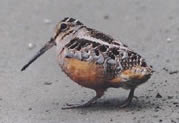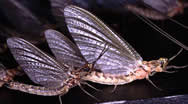
Reports
| Reports | |
Westminster West School Backyard BioBlitz
Event type: Backyard BioBlitz
Number of participants: 2 Teachers, 45 Students
Event date: May 17, 2002
General Description of area surveyed:
The site is an open field edged by forest on the north, west, and
south, with a stream bordered by a marsh along the east side, parallel
to the road. The school (Westminster West School - grades 1-4) is
right across the street.
Overcast
Rainy (we got rained on!)
55° F
Species Found Total Amphibians 4 Reptiles 1 Birds 20 Fish 0 Mammals 1 Insects 4 Other Arthropods 0 Mollusks 0 Plants 47 Fungi
2
Total 39 List of species common names (or description) found:
Plants
Birds
Mammals
solomans seal
American tree sparrow
Beaver
red trillium
blue jay
wild strawberries
robin
Amphibians
apple tree
chickadee
spring peepers
saw grass
goldfinch
red spotted newt
unidentified grass
cliff swallow
red-backed salamander
spruce trees
wood thrush
yellow spotted salamander
rough cinquefoil
Tennesee warbler
plantain
nuthatch
Reptiles
orange hawkweed
woodcock
American toad
cat tails
northern oriole
white pine
red winged blackbird
Insects
thistle
Empidomax flycatcher
black flies
dandelion
yellow throated warbler
mosquitoes
clover
yellow rumped warbler
mayfly nymphs
white violets
ruby throated hummingbird
yellow violets
cardinal
Fungi
jack-in-the pulpet
blackburnian warbler
lichen
golden rod
evening grosbeak
unidentified mushrooms
willow
Canadian geese
hickory tree
spirea
spinulose wood fern
sessile bellwort
northern honeysuckle
columbine
equisetum
curly dock
interupted fern
northern bedstraw
wild parsnip
rush
sedge
sensitive fern
sugar maple
red stemmed dogwood
speckled alder
polytrichium
Japanese honeysuckle
wild blueberry
black cherry
false soloman seal
What species was suprising?
 Woodcock
-it was displaying.
Woodcock
-it was displaying.
What species was the "coolest" and why?
 Mayfly nymph
- lots of them!
Mayfly nymph
- lots of them!
Ms. Beth Kaplin reports:
Two of us worked with the kids from 1-4 grade in the schhol - we broke
them into two groups (one group of 1-2 graders, and other group of
3-4th graders). Each group had sampling equipment, 1-2 graders sampled
in the stream with nets and also sampled in the woods around the stream.
The 3-4 graders went into the field and surrounding woods and sampled
the vegetation and birds. The little kids had a blast sampling in
the stream! We began the project by talking about what biodiversity
is and asking kids to think about it, why its important, etc. Then
we went and sampled, then returned to classroom - the kids drew the
nymphs, drew maps of the site, etc. In the future we would like to
be more prepared to use the resources at your website, and to have
a longer time period with the students.
Register
| About | Organize
an Event | Events
Event Resources | Biodiversity
Facts | Make a Difference
| Contact
Last updated June 27, 2002 16:04

